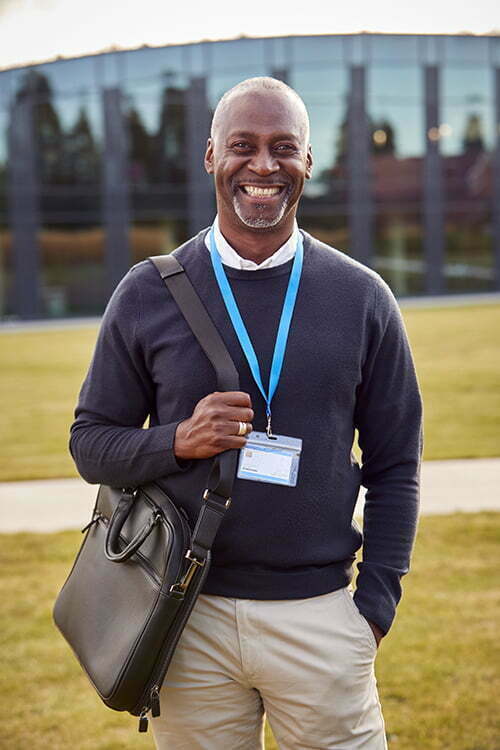
Navigating the future of hosted services
CardSmith, acquired by Blackboard in 2014, in many ways established the SaaS model for card systems and came ready made with a successful solution and client base.
By this point, SaaS is probably sounding like a viable option. But what’s the argument for remaining on premise?
“For starters, there’s regulations,” says Dave Falldien, campus card industry veteran and independent IT consultant. “There are regulations like the Patriot Act, for example, that increase the difficulty of transitioning data across borders.”
There’s just something about the word “data” that sends a chill down people’s spines. “Data in card systems contains personal student data and passing it ‘around the Internet’ is a terrifying thought to stakeholders,” says Falldien. “Keeping an on-premise server – ideally in a private cloud – allows you to move the supporting systems to an off-campus environment while ‘protecting’ the data by keeping it on campus.”
So if there’s an argument for on-premise hosting, then what specific areas of a campus system are better left within the confines of its walls?
“ERP systems are still pre-dominantly on premise and so some campuses continue to have a staff to manage systems onsite,” says Jeff Staples, VP Market Development at Blackboard Transact. “As more campus-related solutions including ERP move to the cloud, the faster we expect other applications to follow that trend.”
Physical security is still largely an on-premise function for campuses. Though it is potentially a powerful use case for the SaaS model, off-premise hosting still seems a ways away in higher education.
“We see scenarios where physical security is leveraging the power of cloud computing; but again, it’s not an all or nothing situation,” says Staples.
CBORD’s VP of cashless systems, Larry Delaney, echoes the sentiment. “Hosted options are simply one more way that we can supply users with the means to carry out their missions. The SaaS decision is specific to each campus, the skills of their teams, and their ambition to commit their resources to other programs,” says Delaney. “Having said that, access control and integrated security solutions tend to be held more closely and managed on campus.”
For access control and door access, in particular, it only makes sense that cloud management of the system will sync with a local system to ensure you have offline capabilities, stresses Blackboard’s Staples.
“You’ll continue to see the application layer live anywhere, but have local presence as well for other components,” he says. “Again, on-premise and SaaS are not mutually exclusive and using them in combination is a very compelling model.”
“Blackboard has continued to make major investments in the platform, and frankly, great software is never ‘done,’” says Staples. “There have been natural synergies bringing the SaaS solution into the Blackboard Transact ecosystem, and we continue to integrate other systems, readers and more with the platform.”
According to Blackboard, the multi-tenant model continues to grow and transaction volumes have nearly doubled in the past three years while average transaction processing time has been cut in half.
Blackboard’s SaaS offering is a true multi-tenant solution, explains Staples. “We pioneered the model, feature the largest deployment, and have learned a great deal over many years from clients in order to enhance our service offerings,” he says. “We also place a strong emphasis on security and deliver PCI-Level 1 services.”
Blackboard’s SaaS is designed to scale to meet the needs of institutions small and large. “Once we centralize the technology, we provide a cadre of managed services – such as live cardholder support and merchant services – to help make the institution and its card program even more successful,” says Staples. “We also have more third-party applications that are certified to integrate with our SaaS solution than any other vendor.”
Campuses don’t have to go full tilt from right out of the gate, but can instead pick and choose what aspects of their systems should be moved to a SaaS model.
“The appetite for institutions adopting SaaS solutions is huge, but it’s not really an either/or scenario,” says Staples. “Some parts of a system can be kept on premise and other parts SaaS. In fact, a large portion of our on-premise clients runs SaaS-based components of their systems.”
We are seeing clients move parts of their system to the cloud even if they haven’t moved the transaction host, explains Staples. “For example, clients are moving to hosted versions of point-of-sale systems, online cardholder account management, etc.”
“In general it seems to be a mix of on and off premise that best meets needs,” says Falldien. “The business benefits of SaaS typically outweigh having servers on premise, however there is still a lot of resistance from people who rely on managing those systems for job security.”
An independent consultant, Falldien always recommends looking at how SaaS can assist the campus as a whole. “I’m a fan of hosting systems and servers in a dedicated off-premise environment and taking full advantage of today’s virtualization options.”




